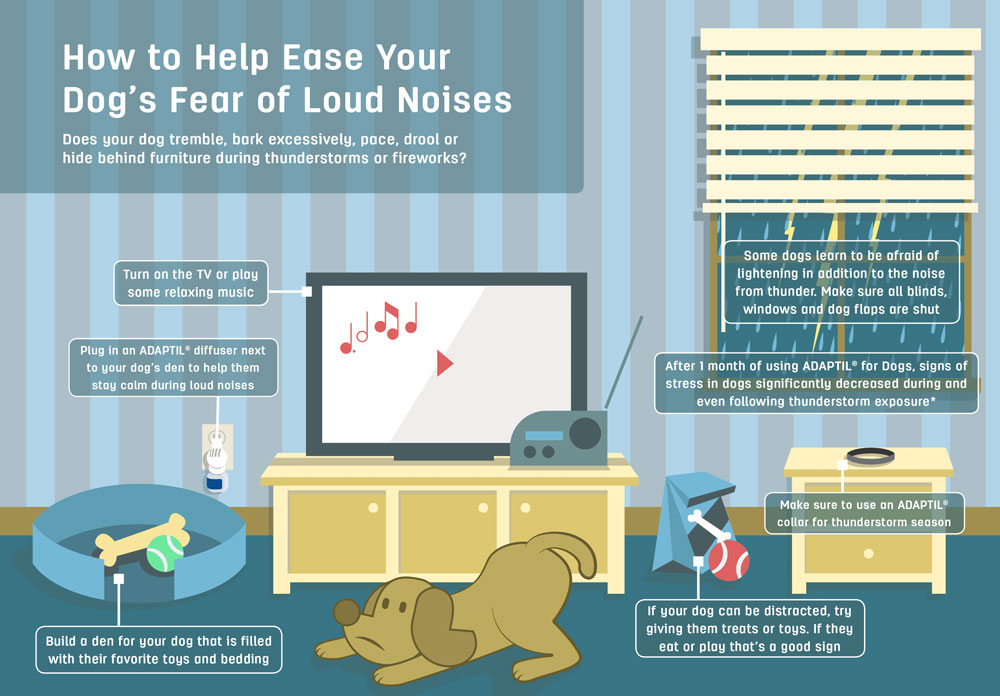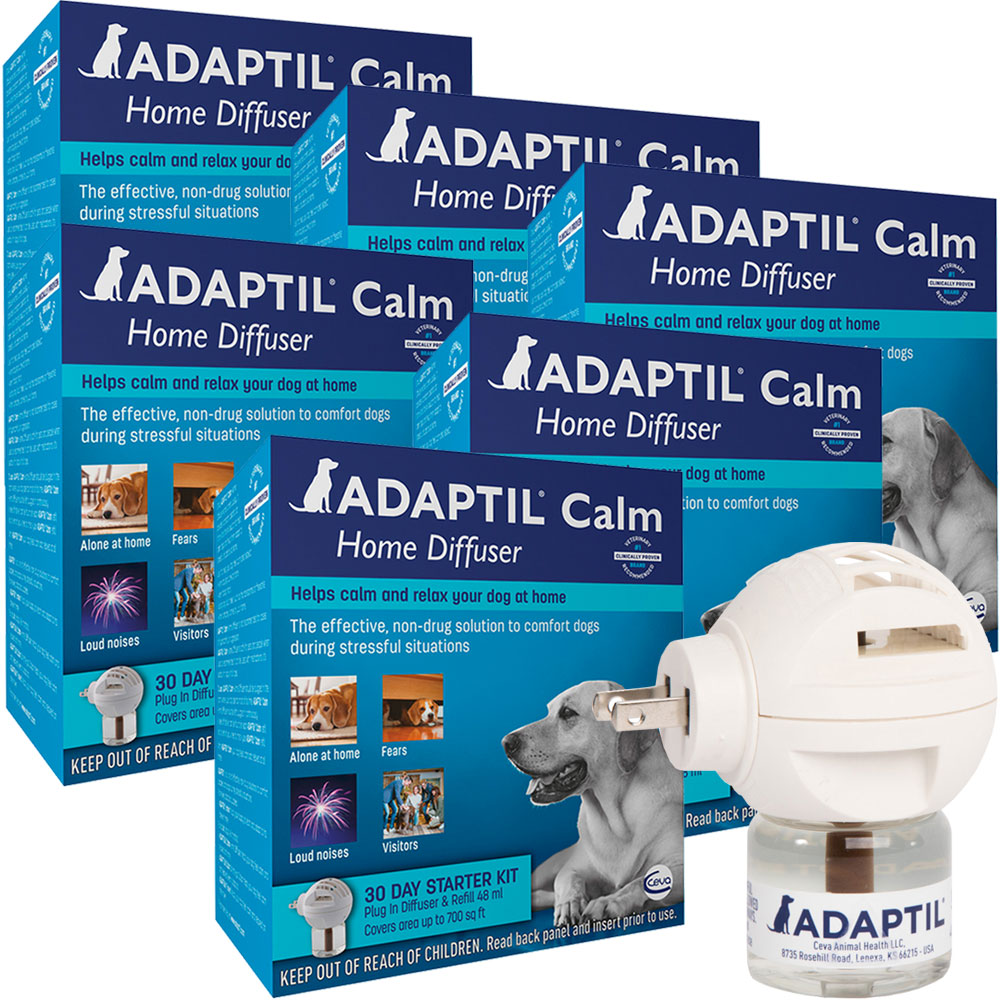6 PACK ADAPTIL Calm Home Diffuser for Dogs (30 Day Starter Kit) 288 ml
Description
Is your dog barking excessively, whining and hiding?
These behaviors are likely caused by fear and anxiety.
ADAPTIL is a clinically proven, drug-free solution that helps your dog feel calmer.
ADAPTIL Calm Home Diffuser provides “comforting messages” (dog appeasing pheromones) that helps dogs feel calm and relaxed in situations like loud noises (thunderstorms and fireworks), staying home alone, or other fearful situations. These odorless messages are only perceived by dogs and provide a strong signal of security and comfort. Cats and people are not affected.
ADAPTIL Calm Home Diffuser starter kit includes one diffuser head and one refill vial.
Plug in diffuser where your dog spends the most time. Should be used continuously for at least 30 days. Covers an area up to 700 sq. ft.
It is recommended to replace the refill every 4 weeks, even if a small amount of liquid remains in the vial (the vial will never be completely empty). Diffusers should be replaced every 6 months.
- #1 brand used and recommended by veterinarians.
- Clinically proven to work.
- Drug-free solution that helps reduce signs of fear and anxiety, like whining, hiding and excessive barking.
- Provides your dog with continuous and constant comfort. Starter kit includes one diffuser head and one vial that lasts up to 30 days.
- 100% satisfaction guarantee.
Useful Information
It's a completely natural reaction to be startled by unexpected loud noises. In fact, a geas response to a loud noise is actually a sensible protective mechanism. But some dogs have a reaction to noise so intense that it seriously impairs their quality of life. These extreme reactions are called "Noise Phobias." Unfortunately, dogs don't outgrow noise phobias and in fact will likely persist and worsen over time if intervention strategies aren't implemented.
Incidence: Phobias associated with noise are not uncommon in dogs and can be seen as early as 9 weeks of age. Research has shown that up to 50% of dogs may have a noise phobia.1 The most common phobias include fireworks, thunderstorms, vacuum cleaners, loud voices, engines, door bangs, party poppers and bird scare devices. Dogs with noise phobias are often fearful of amny loud noises. Dogs of all ages can be afflicted with noise phobias, but in one study 78% of the dogs were between 1-5 yrs of age.
Signs & Symptoms: Dogs react differently to noise phobias. Their reaction can be minor - including whinning or panting - or the reaction can be extreme with the dog fractically trying to escape the home of their enclosure.
-
Some Common symptoms are:
- Trembling
- Barking
- Escaping
- Whimpering
- Cowering
- Vomiting
- Panic
- Seeking human attention
- Shaking
- Hiding
- Whining
- Panting
- Salvatign
- Diarrhea
- Destructiveness
- Inappropriate urination or defecation
Causes of Noise Phobias: No one really knows what causes some individuals to develop noise phobias. Possible causes include: genetic sensitivity to loud noises and sudden traumatic events associated with noise.
-
Dogs at Risk of Noise Phobias: Any dog can develop a noise phobia, but there are some populations of dogs that appear to be more susceptible:
- Dogs adopted from an animal shelter
- Certain breeds such as working group dogs, herding breeds and hounds
- Dogs that were not exposed to noise at a young age, but exposed to noise later in life.
Helping your dog cope: Reacting to noise is very normal and an instinctual response that helps an animal respond to threats. A healthy response to noise is demonstrated by a quick recovery in the dog when it realizes that there is nothing truly threatening. But a dog that develops an intense, persistent fear of noise has developed a phobia and that is a much more challenging problem to overcome. Dogs experiencing phobias can seriously injure themselves in their attempt to escape from what they perceive an immediate life threatening danger.
It's also important to realize that dogs may be experiencing anxiety in response to noises no matter how well they may respond to commands during a storm or other noisy event. Fear and anxiety are biological responses that have nothing to do with the intelligence of the dog. In fact, these responses are completely out of the dogs control once the emotional response has been associated with the event that scares the animal. Even the most well-trained dog who responds to "down" obedience during thunderstorms may still be suffering from fear even if he or she appears to be "well-behaved."

-
Steps you can take to help your dog cope with Noise Phobia
- Develop a treatment plan in conjunction with your veterinarian. It's important to make sure your veterinarian is part of the process, as she can guide you to the right resources, monitor your dog's progress and offer medical intervention if necessary.
- Build a "Safe Area" or Den for your dog to escape from noise when needed. Pick an area that is quiet, away from windows and activity. Your dog may already have an area she favors such as a closet or under the bed. You can create an area by putting a blanket over a kennel. Make sure the area is comfortable, with a dog bed or blankents. Give her treats, toys and chews in the den so that she associates the area with good, positive things. Never force her into this area or lock her into it! It must be a place that she chooses to go because she feels safe there! Also supplement the area with Adaptil pheromone products to help provide additional reassurance. Allow her the freedom to access the den whenever she needs to, and ask the family to leave her alone and not approach her when she is in the den - lettung her come to you when she is ready.
- Use clinically proven pheromones. Adaptil® is te only clinically proven pheromone product to help reduce reactions to loud noises including fireworks and thunderstorms.2,3 Adaptil® is a synthetic copy of a comforting pheromone emitted by the mother dog after birth. These pheromones help comfort and reassure puppies. This pheromone can be detected by dogs of all ages and signals a calm and confident presence. Dor best resilts, start using Adaptil® at least one week prior to the stressul event (if possible), and contine use for a full 30 days. Adaptil® has no contra-indications, can be used long term and also can be used with drug or nutritional therapies.
- Your veterinarian may recommend medication. There are several short-term medications that can be given on an "as needed" basis. There are also drugs that can be given continuously to manage long-term stressful situations. Long-term medications may be more important when the dog has other anxiety related problems.
- Consider desensitization training. If a dog is afraid of noises, desensitization training may be needed. Desensitization means to make less sensitive. It involves a gradual process of exposing the dog to the trigger that he fears with a weak, less threatening version. Over time the dog becomes desensitized to the noise at the weaker level. The noise is slowly intensified until a full or nomal version is reached. You can find more information about this process at ASPCA.ORG.
Behavioral therapy should only be carried out when the chance of exposure to noises is small. It typically takes around 6 weeks to begin to see an improvement, and should therefore be started well ahead of anticipated noisy events such as thunderstorms and fireworks. For fireworks and thunderstorm phobias, behavioral therapy is best introduced in the fall, but may vary region to region.
Help Prevent Noise Phobias in Young Dogs To help prevent noise phobias in puppies, it is important to expose puppies to a variety of mild sounds and stimuli while they are young, Use lots of treats and positive reinforcement when they experience new and potentially frightening things.
- Expose your puppy to a variety of different (mild) noises, lights, handling and movement
- Fit puppies, especially those adopted from a shelter, with an Adaptil collar as soon as they are adopted. Continue using a collar for the next 4 months to help them through the critical learning and socialization phase.
















